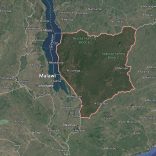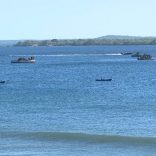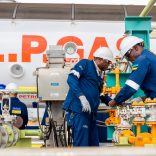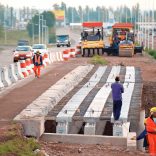Mozambique: State adds heirs of Privinvest owner Iskandar Safa to London case
Beira reconstruction: Resilience is the watchword

Photo: DW
Less than a month before the donor conference for the reconstruction of Cyclone Idai -hit areas, those in charge of planning are stressing that it is necessary to go beyond infrastructure and invest in community education.
The reconstruction plans of the city of Beira will require greater resilience, organisation and preparedness in the event of bad weather – and this goes beyond reinforcing walls, roofs and roads. It is necessary to change attitudes.
“We are going to change our municipal position a bit in terms of the compulsory nature of certain procedures, to avoid further suffering,” Beira mayor Daviz Simango told DW Africa.
“In conversations with the Order of the Engineers, I have said that we have to make new plans, plans to build wind-, cyclone- and storm-resistant infrastructure, and we need evacuation plans,” Simango explains.
The emergency response – including a period in which Beira residents are allowed to carry out reconstruction work without a prior municipal license – should be followed by more structured programmes. The main goal is that all new constructions follow new guidelines concerning resistance to adverse weather.
“It must be understood that, at a time when we were dealing with the immediate effects of the cyclone, we had people living in the open, in the rain, and it was imperative on our part to avoid further human suffering, like people dying from the flu, fevers or other diseases resulting from such exposure,” Simango explained. Municipal authorisation for the immediate replacement of roofs and walls was “a humanitarian issue”.
“Now, in all new construction, the orientation we are setting for families is this: be more resilient. I think this will help families occupy this space of resistance, of durability in buildings,” he says.

Against winds and storms
Daviz Simango reminds us that this is not the first time that Beira has borne the brunt of storms. However, after learning how to deal with rains and flooding, including drainage systems and sea level management, the cyclone showed that the city must be ready to face the worst, and that the authorities were “preparing a manual showing how roofs should be made, the distances between roof support beams, for example, and ensuring that they are all wood or metal structures”.
The manual, says Daviz Simango, will be “simple enough for the population to understand and follow”.
“We’re going to have pieces on TV, plays, handbooks that go out to the communities. We’ll also publish in local languages, and engage with neighbourhood secretaries and local authorities, so that they can help spread the message.”
A message that UN-Habitat, one of the organisations involved in the reconstruction plans of the areas affected by Idai in the centre of the country, also wants to convey as families return to their homes equipped with tarpaulins, mooring systems and other materials serving as a temporary solution to the damage.
According to Francesco Torresani, an expert in post-disaster reconstruction at UN-Habitat in Maputo, more structured programmes will follow. These will include “assisted self-construction programmes, providing neighbourhood-level technical assistance and involving the community in showing families how to build with resilience in mind”.
Torresani also mentioned that the organisation has “a long-standing partnership with the Ministry of Education, along with funding from the World Bank and UNICEF, aimed at making schools more resilient” to high winds and flooding.
PDNA: The basis of resilient reconstruction
Teams assessing the reconstruction priorities in the centre of the country are drawing up plans for after the donor conference scheduled for the last week of May, when the joint World Bank, European Union and United Nations Post-Disaster Needs Assessment (PDNA) report will be presented.
The document, which will have to be approved by the Council of Ministers before being sent to the Post-Cyclone Reconstruction Office, will serve as the basis for the resilient recovery and reconstruction of the areas affected by Idai in Mozambique, Torresani explains.
“The concept of resilience goes beyond physical measures to improving a building’s ability to withstand shocks caused by natural disasters. It also involves reduce communities’ levels of vulnerability,” he explains.
According to Torresani, medium and long-term reconstruction plans would involve changes in policies, laws and codes, taking into account “potential impacts of disasters or increasing trends of climate change”,
“It can lead to a review, for example, of land use plans, building codes, and agricultural development plans.”
For the time being, the PDNA defines “all the actions and costs of activities related to reconstruction by different sectors – water and sanitation, housing, education, agriculture”, among others in all areas affected by the cyclone, allowing donors to identify where will they contribute.
Priorities of a coastal city

In Beira, the priorities for reconstruction is its drainage system – which might have mitigated the effects of the cyclone – and coastal protection, which could include strengthening sea walls and other breakwaters to counter the effects of erosion and waves.
In the opinion of the UN-Habitat expert, “much has been done to increase resilience in the city of Beira, with the rehabilitation and extension of drainage systems, but we must continue this work, extending it further into the peripheral neighbourhoods to alleviate potential floods”.
Soon after the floods caused by the cyclone, the retention basin and the ditches of the city of Beira had to be drained. Now, the municipal authorities are mobilising resources to start the second phase of the drainage system project, with works in the A1 and A3 trenches and in the Estoril [neighbourhood] retention basin. “This will make these areas sustainable in any flood situation,” Daviz Simango says.
Reconstruction plans include the mapping of other vulnerable neighbourhoods, such as Ndunda, Mungassa and Inhamízua, with a view to planning new drainage networks.
Coastal protection is also important, Torresani says. “Much remains to be done, not only in response to the cyclone, but also in the search for medium- and long-term solutions in view of the foreseeable continued increase in vulnerability due to climate change,” he says.
In Simango’s opinion, coastal protection is vital to maintaining the interest of investors. “We have identified the areas in which we have to intervene. Right now, the technical team is consolidating the necessary engineering data for the Dutch team that arrived in Beira on Tuesday (30.04),” he says.












Leave a Reply
Be the First to Comment!
You must be logged in to post a comment.
You must be logged in to post a comment.